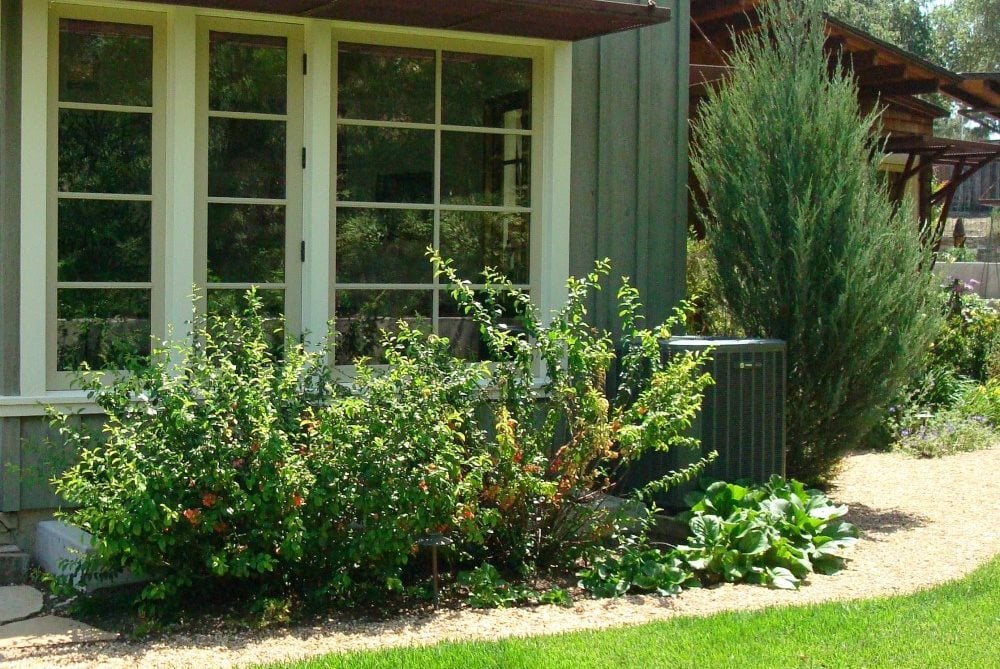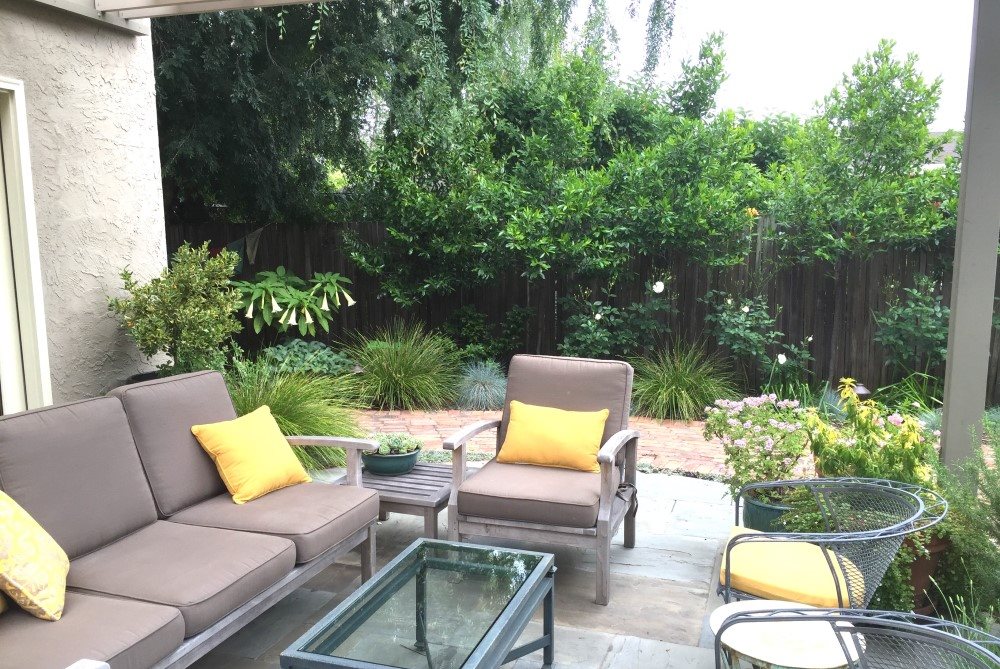Disguising Eyesores in the Garden
Transforming your garden into a captivating oasis often involves tackling unsightly elements that threaten to derail your vision. Having designed gardens for 25 years, I’ve yet to meet a gardener who hasn’t had to deal with at least one eyesore in their garden. From awkwardly placed gas meters, noisy A/C units, or looming neighboring rooflines (just to name a few!), these eyesores can easily detract from the harmony of your outdoor space. However, with a bit of creativity, the following innovative and practical solutions can help blend, hide, or soften these everyday garden blemishes.

A series of strategically placed mid-sized partitions blend harmoniously with this kitchen garden while obscuring unsightly water filters, electrical boxes, and cleaning stations. The French Laundry Garden. Photo by: Rebecca Sweet.
PLANTS TO THE RESCUE!
All gardens have their challenges, whether its disguising an awkwardly located water meter, hiding an unsightly AC unit, or creating a bit of privacy from neighbors. Fortunately, with some careful planning and placement, specific plant varieties are often quite effective at disguising even the most obtrusive eyesores, helping them to blend with your beautiful garden.

Avoid the temptation to plant a single specimen directly in front of the eyesore, which instead of distracting the eye can have the opposite effect. Instead, place an oversized plant or small grouping of plants next to the unit, which re-directs the line of sight to a more pleasant view. The Macomber garden. Photo by: Rebecca Sweet.
Tall Privacy Screening
Privacy is often lacking in suburban neighborhoods with two-story homes built close together. While trees may be an obvious screening solution, narrow lot dimensions or HOA rules can often make this difficult. Luckily, many trees are available with upright, columnar shapes, perfect for tighter spaces, such as Acer ‘Armstrong Gold’, Parrotia persica ‘Persian Spire’, or Celtis occidentalis ‘Prairie Sentinel’. And, don’t forget about larger shrubs that can also be pruned into small trees, such as Prunus caroliniana ‘Bright ‘n Tight’ or Dodonaea viscose (hopseed bush).

A row of fast-growing evergreen Prunus caroliniana ‘Bright ‘n Tight’ shrubs were pruned into a tree shape to obscure the neighboring roofline. Another advantage of using this tree-shaped shrub is it allows opportunities for planting beneath the tree, resulting in a full and layered garden bed in a skinny space. The Miller Garden. Photo by: Rebecca Sweet.
Small to Mid-Size Living Screens
When using a plant to disguise an eyesore, it’s not always about the size of the plant. Often, a plant with oversized, bold foliage can have the opposite effect, drawing attention to the very item you’re trying to hide! Besides the size of a plant, its texture can also play an essential role in helping the offender visually disappear. For example, finely textured plants with small or narrow leaves naturally blend in with surrounding plants. Therefore, when placed near an eyesore, the delicate textures can also help it to recede visually.

The thin, slender blades of the Lomandra ‘Platinum Beauty’ and mondo grass, combined with the delicate foliage of the weeping Japanese maple, help the electrical outlet to recede into this small garden bed. Photo by: Rebecca Sweet.
Vines and Climbers
Vines and climbers can quickly transform oversized, unattractive garden elements, such as a chain-link fence or an obtrusive outdoor chimney, into a canvas for lush foliage and colorful flowers. However, use caution when choosing a vine. Descriptors like "fast-growing" or "quickly covering" often mean the vines can be aggressive and may outgrow smaller spaces. It's important to select vines that are appropriate for your garden's size and conditions. Consider varieties known for being manageable, and always keep an eye on their growth to ensure they don't overwhelm other plants or structures.

A climbing rose or clematis can prevent an oversized, stark chimney from dominating a narrow planting bed while adding delicious scent and gorgeous blooms to the garden. The White garden. Photo by: Rebecca Sweet.
STRATEGICALLY PLACED CONTAINERS
Creative container placement can work wonders for disguising common garden eyesores. When strategically placed, a stunning container can easily hide, or at the very least, take the spotlight off of an unsightly utility box, water meter, or neglected corner. While oversized containers can disguise smaller eyesores, another option is to use a variety of container sizes and shapes to create layers with a more dynamic aesthetic. When planted with vibrant blooms and lush foliage, the eye is taken off the eyesore and back to the garden.

An ill-placed water meter along this narrow side yard pathway is hidden by this creative combination of colorful containers in various colors and sizes. An added bonus is that not only is the eyesore blocked with gorgeous flowers, but the gardener’s shins no longer get banged! The Mitchell Garden. Photo by: Rebecca Sweet.
NARROW ARBORS
Unsightly neighboring rooflines are a frequent frustration in residential neighborhoods and are particularly challenging in smaller gardens where large trees aren't a screening option. Narrow arbors can be an excellent solution, as they have a smaller footprint and can add an elegant framework for climbing plants to grow and camouflage eyesores. When choosing climbing pants, consider those that have fragrant and long-lasting blooms, striking foliage, or multi-season interest.

While the narrow trellis doesn’t completely obscure the neighboring roofline, the combination of evergreen Clematis cirrhosa ‘Wisley Cream’, ‘Climbing Eden’ rose, and large Coprosma ‘Roy’s Red’ is enough to soften the eyesore while adding layered interest to the garden. Photo by: Rebecca Sweet.
SCREENS AND PARTITIONS
When creating a visual barrier to hide an eyesore, don't overlook the impact a decorative screen or partition can have in your garden, whether it’s used as a support for plants or remains unplanted. Let your creativity soar by choosing a fun paint color or a material like wood or metal that complements your garden's aesthetic.
When using a screen to conceal an A/C or HVAC unit, it's crucial to consider the plant's well-being and the unit's functionality. Be mindful of the distance between the screen and the plants, ensuring a gap of at least two to three feet for proper air circulation. Moreover, choose plants that can tolerate the hot air blowing directly on them. This way, you can maintain a balance between aesthetics and practicality in your garden.

The bright green color of this wooden screen adds personality to an otherwise uninspired corner dominated by the air conditioning unit. Even though the Star Jasmine is planted 3 feet away from the unit, the homeowner still keeps a close eye on it to ensure it won’t grow out of bounds. Photo by: Rebecca Sweet.
CUSTOM CONTAINMENT
Sometimes, the best solution for hiding unsightly but necessary everyday items (such as garden tools, bags of garden soil, waste bins, etc.) is to contain them with clever customized structures. This is especially effective when placed within a side yard, which is typically out of sight from the main garden and the perfect place to store bulky items. Painting structures the same color as the home helps draw attention away from them and places the focus back onto the garden.

This gardener has ingeniously created a dedicated storage area for bulky garden tools and equipment. The wooden storage units seamlessly blend with the fence, home, and garden, creating a harmonious combination. The vibrant, layered planting beds nearby add a pop of color, resulting in a side yard that’s not just functional, but also a feast for the eyes. The Marschin garden. Photo by: Rebecca Sweet.
CREATIVE PATHWAYS
Cleverly designed pathways are highly effective in diverting attention away from eyesores by guiding visitors towards more visually appealing areas of the garden. Incorporating gentle curves in the pathway creates a sense of journey and discovery, encouraging exploration and engagement with the garden.
When using materials like gravel or stone, the pleasing crunching sound underfoot can enhance the sensory experience, drawing attention to the pathway and surrounding plants. While this auditory element is subtle, it’s one more way to help shift the focus away from less attractive features.

The textural plants bordering the curving pathway, combined with the satisfying crunch of gravel underfoot, draw attention away from any nearby eyesores. Designed by Bernard Trainor. Photo by: Rebecca Sweet.
CREATE A DIVERSION
Add some personality to your garden while diverting attention from eyesores by strategically placed artwork, sculptures, and water features. For example, transform an ordinary fence into a focal point by adding colorful containers, art pieces, or even a living wall. Or, create an illusion of depth and space while deflecting attention from unattractive elements by placing mirrors throughout the garden. Incorporating a water feature not only attracts wildlife but also introduces a soothing sound that adds a sense of calm to the garden.

The industrial cinderblock wall is softened thanks to the attached antique mirror. The mirror’s reflective qualities take the eye off the wall while simultaneously making the garden appear more expansive. The Hill Garden. Photo by: Rebecca Sweet.
WHEN ALL ELSE FAILS
Sometimes, an eyesore is so unique that it can't be hidden, so the best approach is to embrace it and try to incorporate it into your garden’s overall design. Fire hydrants are a typical example of this, as they must remain visible for safety reasons, so covering them up isn’t an option. In such cases, you can turn the eyesore into an intentional feature by planting around it with complementary colors and unique plant selections that draw the visitor’s eye to the plants rather than the object itself.
For instance, consider using flowers or foliage that echo or complement the color of the hydrant, resulting in a cohesive and integrated part of the garden. This approach not only maintains the functionality of necessary objects like fire hydrants but minimizes the distraction in the garden.

While there’s no disguising this eyesore, the burgundy tones of the epimedium’s foliage echo the rusty, muted colors of the fire hydrant, making it one of the most attractive fire hydrants in the city! Ciscoe Morris’s sidewalk garden. Photo by: Rebecca Sweet.

BOOK REBECCA AS YOUR NEXT GARDEN SPEAKER!
Fun, passionate, and knowledgeable, three words that describe Rebecca Sweet! See what discussion topics are available and watch a short video as Rebecca explains how her talks will inspire, entertain, and educate gardeners at all skill levels.
RELATED:
More from Rebecca Sweet
Unexpected Surprises in the Garden
Creating Echoes in the Garden
Designing With Foliage Over Flowers
Make Your Garden Containers Work For You
